![]()
Canon had a strong 2024, launching a new flagship camera, a highly anticipated (and excellent) sequel to the popular EOS R5, and a bunch of diverse new lenses.
Four Powerful New Cameras
While 2023 saw Canon focus heavily on its consumer-oriented cameras with models like the Canon EOS R50, R100, full-frame R8, and the compact vlogger PowerShot V10, 2024 was the year of the pro for Canon.
In mid-July, Canon unveiled the EOS R5 Mark II and the long-awaited flagship EOS R1.
While the R1 was meant to be the more exciting of the two based on Canon’s marketing approach to the double launch, the R5 II has thus far proved much more interesting for a broader range of photographers thanks to its excellent blend of resolution (45 megapixels) and speed (continuous RAW shooting with AF/AE up to 30 frames per second). The R5 II is a remarkable camera and lost to the Sony a9 III in PetaPixel‘s 2024 Awards by just a single point.
“What the Canon R5 Mark II represents is Canon’s most capable all-round camera to date and it is easy to see why it has overshadowed even the EOS R1,” writes Chris Niccolls in PetaPixel‘s Canon EOS R5 Mark II Review. “I think many Canon shooters will opt to go with the R5 Mark II as a preferred tool for shooting sports, action, and wildlife, even though the R1 and R3 are more specialized tools in this regard.”
The EOS R1, Canon’s other new photo-oriented (although still decidedly hybrid) camera of the year is also excellent, although decidedly less versatile than the R5 Mark II. The Canon EOS R1 is blazing fast and capable of shooting with impeccable autofocus performance at up to 40 frames per second. However, it is held back somewhat by its relatively low pixel count (24 megapixels) and high cost ($6,299).
As Niccolls writes, the R1 is “a flagship made for a select few.” The R1 is a very powerful camera for that relatively small audience. It features an excellent dual-gripped design, has among the best EVFs on the market, and is exceptionally reliable.
“Perhaps the Canon R1 is too specialized for its own good and many of the people we spoke to who tested the R1 found the R5 Mark II to be the more useful choice given its greater versatility. The R1 seems to be covering territory already trodden by the EOS R3,” Niccolls posits. “That being said, the R1 is incredible at what it does. It shoots faster than almost every camera except the Sony a9 III, is rugged and reliable, and can shoot non-stop for a long time. The autofocus is reliable and good at tracking many different subjects. Canon makes excellent sports glass too, which the R1 takes full advantage of.”
Canon’s third and fourth cameras of the year are cinema cameras. While we didn’t review the Canon EOS C400 announced in June or the C80 that debuted a few months after, they are well worth taking second looks at.
Both cameras feature stacked full-frame 6K image sensors with triple-base ISO, RF lens mounts, and Dual Pixel CMOS AF II. The C400 sports an expandable and very riggable boxy cinema camera design, while the C80, like its predecessor the C70, has a more “regular” camera shape, albeit a thick one to support all the necessary ports and internal active cooling system.
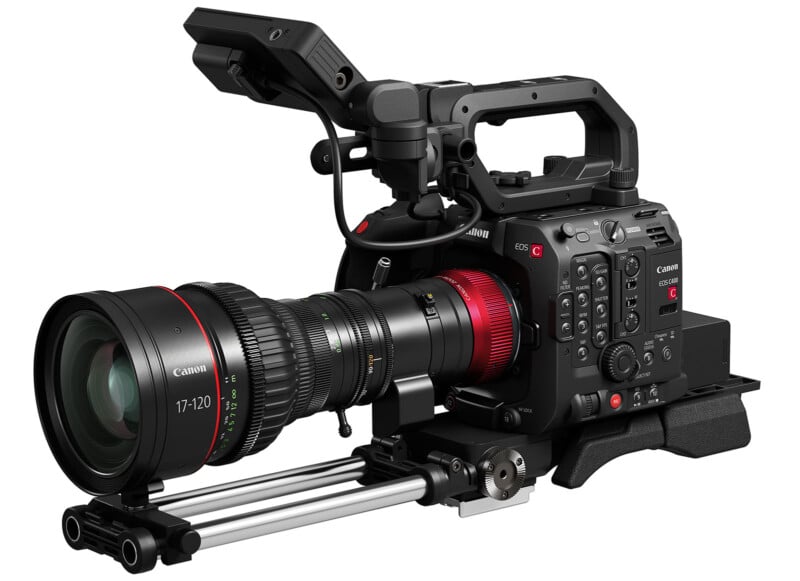 A Rigged Canon EOS C400 | Credit: Canon
A Rigged Canon EOS C400 | Credit: CanonThe C400 arrived none too soon for Canon, as the company needed a robust response to Nikon’s acquisition of RED a few months prior. Canon has always held a strong position in video, and the C400 — and later C80 — represents the company’s continued commitment to high-end video.
 Canon EOS C80 | Credit: Canon
Canon EOS C80 | Credit: CanonLots of Lenses, Some Very Unusual
Canon’s commitment to video goes far beyond its new C400 and C80 cinema cameras — it also carries over to the company’s new RF glass this year.
We’re going to go out of order a bit in this section to group similar lenses together, but we will start at the very beginning, the Canon RF 35mm f/1.4 L VCM lens announced in early June. This fast prime lens is explicitly designed to work equally well for photo and video applications, and at the time of its unveiling, Canon noted that it would be the first in a new hybrid series of prime lenses.
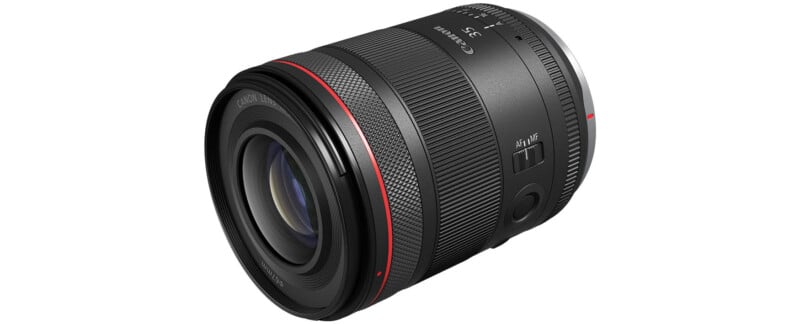 Canon RF 35mm f/1.4 L VCM | Credit: Canon
Canon RF 35mm f/1.4 L VCM | Credit: CanonThe 35mm f/1.4 L VCM features a de-clicked aperture control ring, minimal focus breathing, classic L-series optical performance, and a swift, smooth autofocus system backstopped by a hybrid Nano USM (ultrasonic motor) and VCM (voice coil motor) system. The 35mm f/1.4 L VCM marked Canon’s debut of a VCM lens, although it was not the last of 2024.
In late October, Canon announced two more f/1.4 VCM primes: the RF 24mm f/1.4 L VCM and the RF 50mm f/1.4 L VCM. Like the RF 35mm f/1.4 L VCM, these new primes are built for hybrid creators, meaning they have de-clicked aperture control rings, hybrid Nano USM and VCM motors for autofocus, and optical formulae designed to reduce focus breathing.
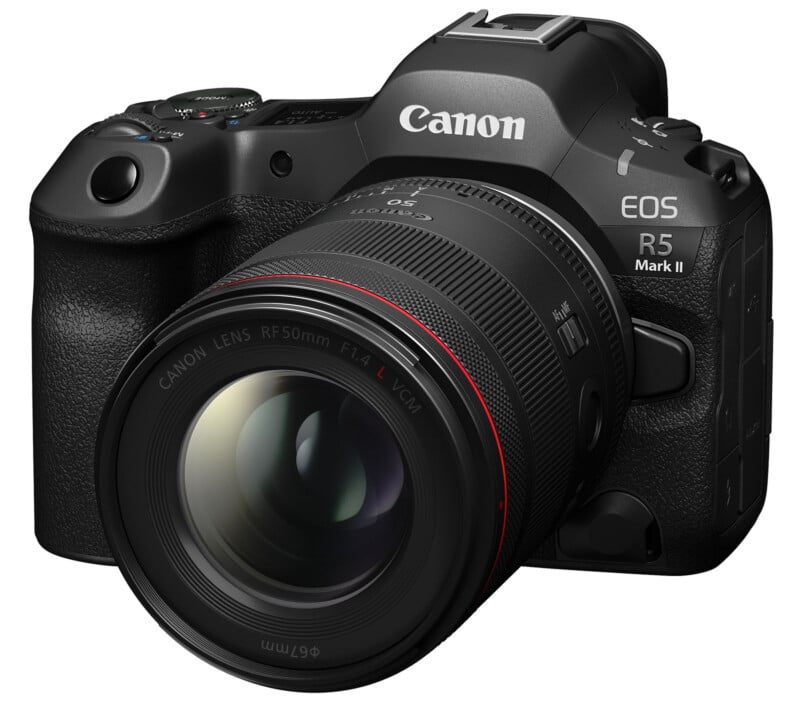 The Canon EOS R5 II is a fantastic hybrid camera — Canon’s best, in fact — and all three of the company’s new VCM prime lenses are ideally suited for recording high-quality video on the R5 II. | Credit: Canon
The Canon EOS R5 II is a fantastic hybrid camera — Canon’s best, in fact — and all three of the company’s new VCM prime lenses are ideally suited for recording high-quality video on the R5 II. | Credit: CanonTwo more Canon lenses fit nicely into a grouping, the RF-S 3.9mm f/3.5 STM Dual Fisheye and the RF-S 7.8mm f/4 STM Dual Lens. These new lenses are designed to create virtual reality and 3D content, joining the RF 5.2mm f/2.8 L Dual Fisheye released in late 2021.
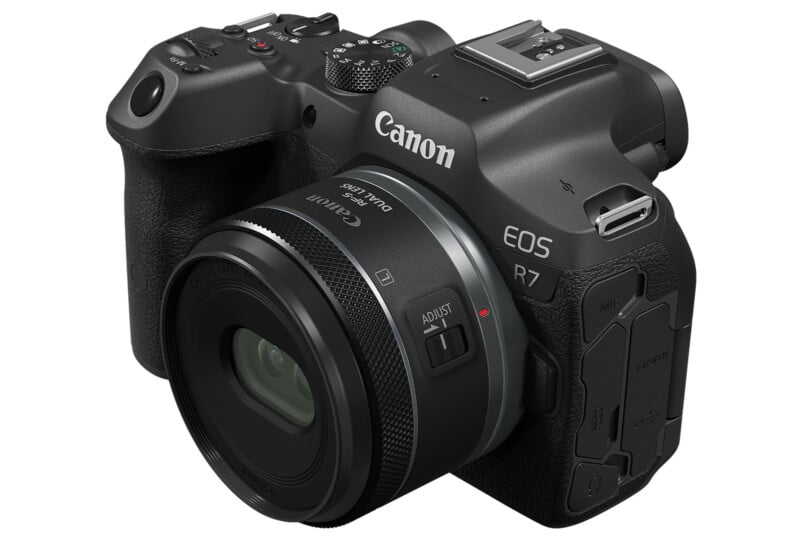 Canon RF-S 7.8mm f/4 STM Dual Fisheye
Canon RF-S 7.8mm f/4 STM Dual FisheyeIn September, Canon announced a new lightweight zoom lens for full-frame cameras, the RF 28-70mm f/2.8 IS STM. Priced at $1,099, the lens is an affordable f/2.8 alternative to the RF 24-70mm f/2.8 L IS announced in 2019.
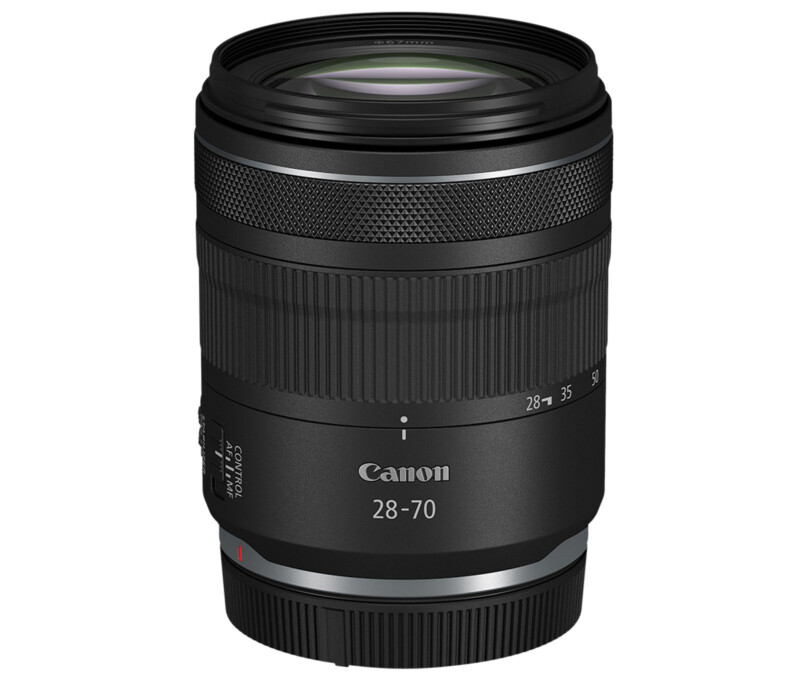 Canon RF 28-70mm f/2.8 IS STM lens | Credit: Canon
Canon RF 28-70mm f/2.8 IS STM lens | Credit: CanonThe RF 28-70mm f/2.8 is $1,000 cheaper after accounting for a $300 discount on the 24-70mm f/2.8 while weighing just over half as much and being more than 50% shorter. Canon believes the RF 28-70mm f/2.8 is an affordable step-up lens for photographers who want something faster and better than a kit lens.
Canon’s final lens of the year is its most expensive, the RF 70-200mm f/2.8 L IS USM Z. Targeting professional hybrid users, the $3,000 lens promises improved video performance and usability compared to the existing RF 70-200mm f/2.8. The advantage of the older one is that it’s cheaper, lighter, and smaller.
The new RF 70-200mm f/2.8 L IS USM Z lens is an internally zooming lens that works with Canon’s optional power zoom motor, which adds even more to the high cost. As Niccolls writes in his review, the new 70-200mm f/2.8 zoom lens is exceptionally sharp, incredible for video, and so expensive that most photographers should instead opt for Canon’s other 70-200mm f/2.8 lens, unless they desperately want teleconverter compatibility.
“Regardless, you’ll get a fantastic lens no matter which way you go,” Niccolls says of photographers choosing between Canon’s two 70-200mm f/2.8 lenses.
For those thinking the new 70-200mm f/2.8 Z lens looks familiar, good eye. The RF 70-200mm f/2.8 L IS USM Z shares the same chassis as the RF 24-105mm f/2.8 L IS USM Z announced last year. While this lens was discussed in the 2023 Canon recap, it is worth mentioning again here because our review for the lens dropped in 2024.
Grading Canon in 2024
Although it doesn’t always feel like Canon is heading in the best possible direction, the longtime camera giant had a terrific year. The Canon EOS R5 Mark II and EOS R1 are excellent cameras, especially the R5 II. Canon’s new series of f/1.4 primes are great for photographers and videographers alike, and the 70-200mm f/2.8 zoom is superb, albeit very pricey. While there are plenty of reasons to debate Canon’s broader mirrorless strategy, there’s little doubt that 2024 was a very strong year for the company. Canon’s performance this year is held back only by a lack of development in the APS-C space, where the only meaningful news of the year came from third parties launching RF-S lenses.
Grade: A-
Image credits: Featured image created using an asset licensed via Depositphotos.




/cdn.vox-cdn.com/uploads/chorus_asset/file/25825874/fortnite_festival_multiplayer.png)

 English (US) ·
English (US) ·